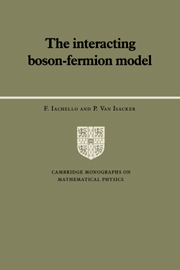Book contents
- Frontmatter
- Contents
- Preface
- Part I The interacting boson-fermion model-1
- 1 Operators
- 2 Algebras
- 3 Bose-Fermi symmetries
- 4 Superalgebras
- 5 Numerical studies
- 6 Geometry
- Part II The interacting boson-fermion model-2
- Part III The interacting boson-fermion model-K
- Part IV High-lying collective modes
- References
- Index
5 - Numerical studies
Published online by Cambridge University Press: 07 October 2009
- Frontmatter
- Contents
- Preface
- Part I The interacting boson-fermion model-1
- 1 Operators
- 2 Algebras
- 3 Bose-Fermi symmetries
- 4 Superalgebras
- 5 Numerical studies
- 6 Geometry
- Part II The interacting boson-fermion model-2
- Part III The interacting boson-fermion model-K
- Part IV High-lying collective modes
- References
- Index
Summary
Introduction
Dynamic symmetries and supersymmetries provide a convenient framework within which spectra of nuclei, either individually (symmetries) or in a set (supersymmetries) can be analyzed. However, they usually provide only a first approximation to the observed properties and furthermore there are nuclei for which they cannot be used. In these cases, one needs to do numerical studies. The starting point for these studies is the diagonalization of the Hamiltonian for the combined system of bosons and fermions written in one of its forms. Computer programs are available for the numerical solution of this problem (Scholten, 1979). The structure of the Hamiltonian is as in (1.16). Numerical studies are done by first analyzing the spectra of even-even nuclei as in Volume 1. This analysis determines the parameters appearing in HB. In a second step, the spectra of odd-even nuclei are studied. For odd-even nuclei with one unpaired particle, HF contains only the single-particle energies, ηJ. If states originating from only one single-particle level are studied, there is only one single-particle energy, η, which can be chosen as zero on the energy scale. If states originating from m single-particle orbits are included, the number of input parameters for the calculation is m – 1, since the lowest level can be chosen as zero on the energy scale. The crucial property that determines the structure of spectra of odd-even nuclei is the coupling between the collective degrees of freedom (bosons) and the single-particle degrees of freedom (fermions).
Information
- Type
- Chapter
- Information
- The Interacting Boson-Fermion Model , pp. 188 - 205Publisher: Cambridge University PressPrint publication year: 1991
